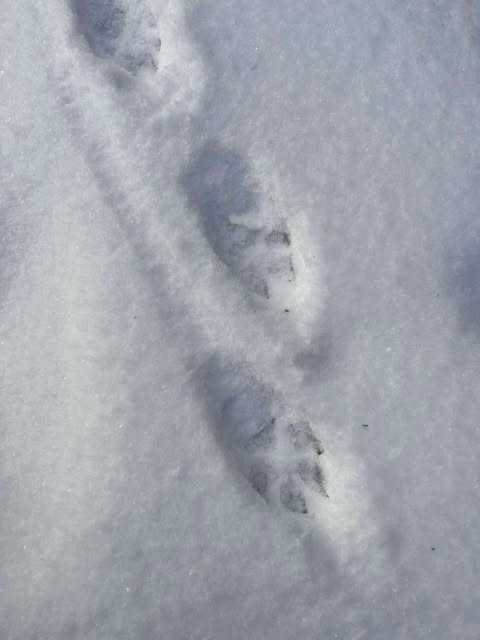
One of my goals for this year was to begin tracking wolves as soon as January arrived—a peak time for howling. I was eager to get out and hear them. Initially, I had another location in mind, but, by chance, found signs of them while on a walk, leading me to try this spot: the Owl Mountains, Poland.
I first saw signs of wolves here in August 2024, and began preparing to record them from that moment. However, I didn’t actually start recording until December.
Finding the wolves
Returning in winter, the snow made it easier to find tracks. I located the pack after a few days, and, over one or two weeks of tracking, started identifying patterns in their movement. Based on these patterns, I positioned my microphones in areas they frequently passed through.
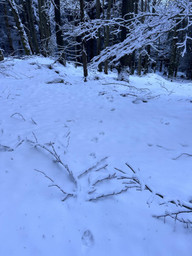
One particular spot seemed to serve as a rendezvous point. For weeks, they followed the exact same trail past a fallen tree, marking their territory along the way. I found various signs of this, including hair on trees they rubbed against, and scat in the snow.
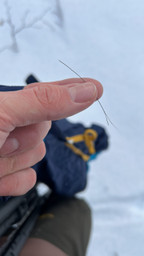
Communication beyond howling
What fascinates me most about physical signs like hair, scat, and urine is that, while they may seem insignificant to us, they are essential forms of communication for wolves. Though most people associate wolf communication with howling, these subtle territorial markers are just as impactful and powerful.
Wolves use a range of vocalizations, including howls, barks, yaps, whines, and growls, to communicate as a pack. Being able to record and experience these sounds in the wild is an incredible privilege, offering deep insight into their behavior.
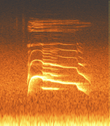
Understanding their range
At first, I believed that multiple packs were spread across the mountain range. However, I later learned that just one pack was traveling vast distances – something confirmed by locals and other wolf enthusiasts who have followed them over longer distances.
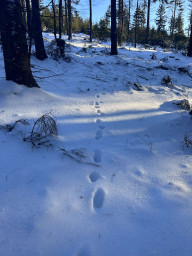
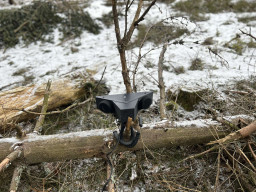
Though I can’t precisely determine the full extent of this pack’s range or the size of its territory, wolf territories in Central Europe typically span 100–350 km² [62–217 square miles]. In areas with lower prey densities, such as northern Siberia or Canada, territories can exceed 1,000 km² [621 square miles].
Ethical considerations around wolf tracking
Tracking and recording wolves comes with great responsibility. Wolves are highly protective of their territory—not just against other packs but also against human disturbance. Excessive human activity can cause them to alter their routes, abandon dens, and even relocate entirely. If disturbed at the wrong time of year, they may abandon their pups.
To minimize my impact, I focused on a small section of their territory rather than exploring extensively. Local conservationists advised me that March to August is a particularly sensitive period, during which it is crucial to avoid clear-cut woodland, refrain from searching for dens, and limit overall disturbance.
My approach has always prioritized the well-being of the wolves; before recording, I research their behaviors and seasonal patterns to ensure minimal intrusion.
Seasonal changes in activity
From January to March—the mating season—wolves do not yet have pups, but are highly vocal. In this location, their howling peaked in January and gradually decreased by late March. Their movement patterns remained steady, though they seemed to stay in one area more frequently.
Heavy snowfall sometimes appeared to reduce their activity, though it is unclear whether they were truly less active or if wind conditions simply prevented their howls from reaching my microphones. Either way, by mid-March, their vocalizations had significantly decreased, likely in preparation for new pups.
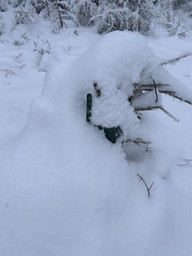
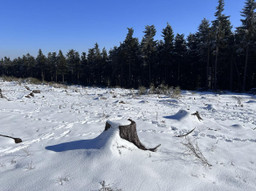
A new discovery
Recently, I found a new location used by the wolves. Reaching it meant wading through a freezing river and knee-high snow—far from a pleasant experience with wet clothes, socks, and shoes! However, this effort led to several successful recordings of various wolf sounds being made over a three-month period.
After reviewing trail camera footage from this site, I observed tracks and behaviors that seemed more playful than territorial. At first, I believed some sounds indicated fighting within the pack, but, upon closer analysis, they appeared to be playful interactions. I initially sent a recording to [Earth.fm curator] Melissa Pons for her opinion, and after watching the video (attached), we concluded that the activity was more social than aggressive.

Supporting wolf conservation
If you wish to support wolves and their conservation in Europe, now is a critical time. Political changes threaten to strip wolves of their protected status, making them more vulnerable. If you are able, please consider donating to or otherwise supporting local wolf conservation projects.
The Sound Hunter
And I think this leads to a reflection about my status as a recordist in nature with an interest in tracking wildlife, and the crossover this might have with hunting. (Which is in no way an endorsement of hunting.)
Though I don’t call myself a sound hunter, I do hunt for sounds, capture them, and return home to display them on the ‘walls’ of my social media.
The first chapter of Josef Brunner’s Tracks and Tracking (1909), states: “Nature is an open book to the man who can read the signs of woods and plains correctly” – going on to reference hunting and the trophy as a result of successful tracking.
No animals were harmed during my recording activities, and only their vocalisations were captured. However, it’s a difficult not to compare oneself to a hunter. I intrude into a natural habitat to capture sound, and then leave with some form of trophy – if I’m lucky, the subject I hoped to record. Though, with tracking, the need for luck is reduced.
Learning to track wildlife has been eye-opening in allowing me to read the forest, understand animal behaviour, and become aware of my own limits and those I should impose as a recordist. Tracking can hugely improve your field craft. An example, outside wolf recording, might be positioning microphones in places where you know birds might go to feed. The image on the left shows signs of a bird eating spruce pine cones on the root of a tree. I also found similar signs on a rock nearby.
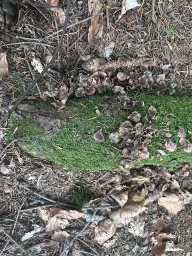
The trails I walked in the forest are shared by hunters, and their hides dotted the forest and meadows that are also frequented by wolves. Given current laws, these places could also be one of concern for the wolves and other inhabitants of the forest. I think tracking can also teach you to understand animal behaviour, and, as an outsider, to not overstep your boundaries in the habitat you work in.
Capturing sounds and gathering sound effects with our shotgun microphones in the forest.
Capturing and gathering are two words that immediately spring to mind when talking about wildlife sound, or SFX recording in general. As we all consume audio, perhaps that likens us even more to hunters, as we are using their terminology to some extent.
This experience has been an incredible journey of learning and discovery. Understanding wolves through both their vocal and physical signs has deepened my appreciation for these remarkable animals. With careful observation and ethical tracking, we can continue to study them while ensuring their safety and preservation.
📍 Here is a playlist of wolf recordings I’ve made over the past few months:
📍 And an amazing, existing Earth.fm playlist from other contributors to the platform!
All photos and recordings courtesy of Phil Mill
Earth.fm is a completely free streaming service of 1000+ nature sounds from around the world, offering natural soundscapes and guided meditations for people who wish to listen to nature, relax, and become more connected. Launched in 2022, Earth.fm is a non-profit and a 1% for the Planet Environmental Partner.
Check out our recordings of nature ambience from sound recordists and artists spanning the globe, our thematic playlists of immersive soundscapes and our Wind Is the Original Radio podcast.
You can join the Earth.fm family by signing up for our newsletter of weekly inspiration for your precious ears, or become a member to enjoy the extra Earth.fm features and goodies and support us on our mission.
Subscription fees contribute to growing our library of authentic nature sounds, research into topics like noise pollution and the connection between nature and mental wellbeing, as well as funding grants that support emerging nature sound recordists from underprivileged communities.
